It’s a picture-heavy, rather than text-heavy, article this week. First though, some context…
The Victoria line is arguably the nadir of London Underground design. Opened in stages between 1969 and 1971, it did so against a background of under-investment, terrible industrial relations (as with London Underground, so with Britain as a whole, to be honest) declining passenger numbers, and an apparent complete neglect of London Underground/London Transport’s considerable design heritage. The decline started after the end of the Second World War, with design champion and chief executive Frank Pick having left a few years earlier in 1940. There were some post-war successes, mostly on the London Buses side of the operation, with dramatic buildings such as the now-iconic Stockwell Bus Garage, Newbury Park Bus Station and Peckham Bus Garage. But the decline in standards was visible elsewhere as pre-war designs for stations on the Central line’s eastern extension were scaled down. Despite some lovely design touches such as the skylights at Redbridge they were pale shadows of the Underground’s pre-war stations.
Design standards eventually got so bad that London Transport’s famous bespoke Johnston typeface was frequently abandoned on posters and publicity, in favour of a mixed bag of other typefaces, seemingly picked at random and giving the impression that no-one cared what image London Transport presented to the world.
Somehow, despite London Transport’s general malaise, the construction of the Victoria line was authorised. It was a scheme that had been kicking around since the 1940s. When the first part of it opened in 1969, it transformed connections across central London and ushered in an early form of automatic train control giving faster journeys.
Yet London Underground somehow contrived to cause its brand new tube line to look as though it had been built a decade or two earlier and neglected ever since. A colour palette (if you could call it that) of grey ‘enlivened’ with white and black highlights, and a key design element of cheap grey tiling, along with grey panelling, grey flooring, lots of stainless steel, and aluminium-finished trains (no need for expensive paint jobs) gave the whole operation an unutterably dreary appearance, as though already grimy from years of use and indifferent cleaning. In fact, the overall look of the Victoria line was overseen by Misha Black at Design Research Unit (creators of British Rail’s double arrow corporate identity). He was recorded as saying that the whole grey-scale approach was deliberate, to make passenger information signage stand out better (Ovenden, 2013). Nothing to do with keeping costs down at all then. Oh well, that’s all right.
The stations built and rebuilt for the Victoria line have no architecture worth mentioning. In fact there are only two design features of any note on the line. The first is a decorative ventilation shaft in Gibson Square. The second is the only concession to decorative colour along the line. On the platforms of each station are several benches, and behind those benches are recesses infilled with a tiled mural unique to the station. Each one reflects something of the heritage of the local area or the station name. It’s only a small thing, but in the design desert of the Victoria line, they are oases of interest, and about the only thing I’m grateful to DRU for on the Victoria line.
There are 16 stations on the line, and 16 different mural designs. From south to north (because I’m saving the best one to the end), here they are.
Brixton’s mural is a pun (a ton of bricks) by Hans Unger. Lol:

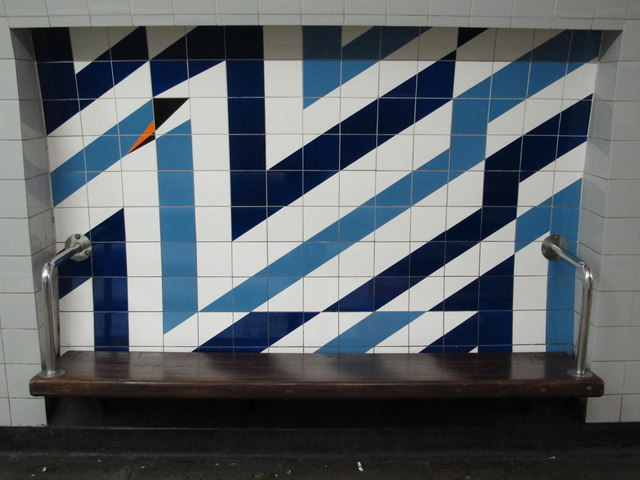
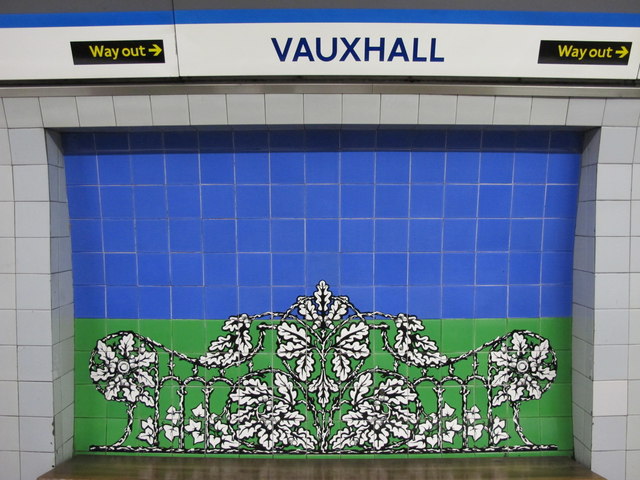
![Pimlico mural. By andrew (originally posted to Flickr as PIMLICO) [CC BY-SA 2.0], via Wikimedia Commons](https://thebeautyoftransport.files.wordpress.com/2016/04/600px-pimlico.jpg?w=768&h=768)
For Victoria station, a silhouette of Queen Victoria, after whom both the mainline station and the line itself are named, forms the design. The artist was Edward Bawden, a long-time friend of Eric Ravilious and frequent contributor to London Transport publicity:
![Victoria mural. Oxyman [CC BY-SA 2.0], via Wikimedia Commons](https://thebeautyoftransport.files.wordpress.com/2016/04/blue_cameo_of_queen_victoria_on_pink_background_by_edward_bawden-_-_geograph-org-uk_-_614599.jpg?w=768&h=576)
Green Park’s mural, by Hans Unger, is supposed to be an abstract representation of trees in Green Park itself:
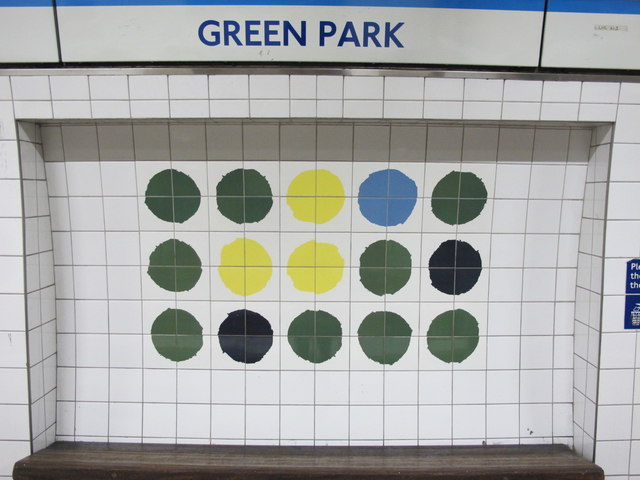
Oxford Circus is another mural that has had a slightly complicated history. The original version by Hans Unger was replaced in 1984 by a design matching that on the Bakerloo line platforms, which features escalators. The original Unger design, an abstract representation of Oxford Circus and its Underground line interchange, was restored in 2009:
![Oxford Circus mural. Photo by Daniel Wright [CC BY-NC-ND 2.0] via this flickr page](https://thebeautyoftransport.files.wordpress.com/2016/04/26463512632_6dea96f828_z.jpg?w=768)
Warren Street’s mural features another hilarious visual pun, as it includes a maze (or warren) to a design by Crosby, Fletcher and Forbes:
![Warren Street mural. Photo by Daniel Wright [CC BY-NC-ND 2.0] via this flickr page](https://thebeautyoftransport.files.wordpress.com/2016/04/26529887206_45b22ee45c_z.jpg?w=768&h=575)
Euston’s lost arch (or whatever you want to call it) appears on Tom Eckersley’s mural at Euston:
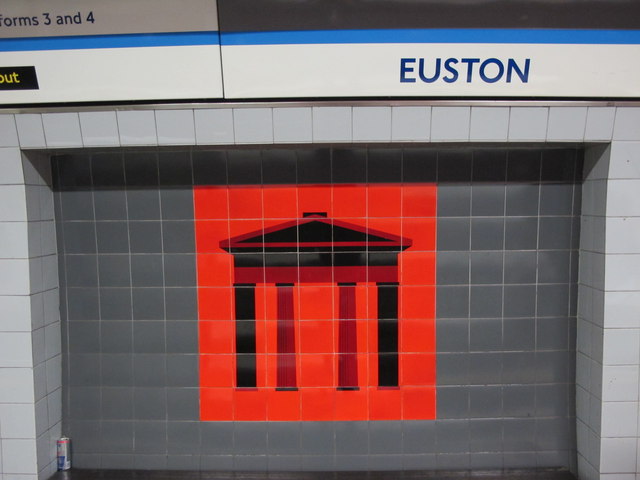
![Mural at King's Cross St Pancras. One of the tiles appears damaged. Photo by Daniel Wright [CC BY-NC-ND 2.0] via this flickr page](https://thebeautyoftransport.files.wordpress.com/2016/04/26489847531_615fd86744_z.jpg?w=768&h=575)
The castle which used to stand nearby is illustrated on the mural at Highbury & Islington, to a design by Edward Bawden:

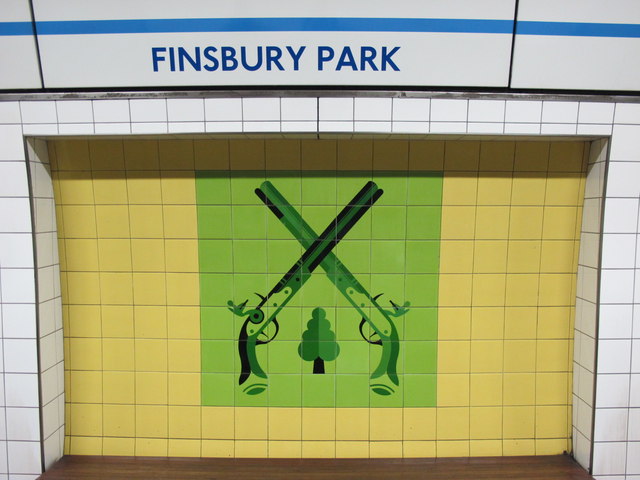
![Seven Sisters mural. By Panhard (Own work) [GFDL, CC-BY-SA-3.0, CC BY 2.5, GFDL or CC BY-SA 3.0], via Wikimedia Commons](https://thebeautyoftransport.files.wordpress.com/2016/04/640px-seven_sisters_station_034.jpg?w=768&h=576)
Edward Bawden’s mural for Tottenham Hale shows the ferry which used to transport passengers over the River Lea:
![Oxyman [CC BY-SA 2.0], via Wikimedia Commons](https://thebeautyoftransport.files.wordpress.com/2016/04/ferry_across_the_river_lea_motif_at_tottenham_hale_tube_station_-_geograph-org-uk_-_614578.jpg?w=768&h=576)
Blackhorse Road has a mural of a black horse, by Hans Unger (his least abstract for the line):
![Blackhorse Road mural. Photo by Oxyman [CC BY-SA 2.0], via Wikimedia Commons](https://thebeautyoftransport.files.wordpress.com/2016/04/tile_design_at_blackhorse_road_underground_station_-_geograph-org-uk_-_1767778.jpg?w=768&h=576)
I’ve saved the best until the end, though. The Victoria line’s northern terminus at Walthamstow is close to the William Morris Gallery, in the house where Morris himself lived. There can be no more appropriate mural than an adapatation of a Morris design, and it was undertaken by Julia Black. While arguably not useful (except in assisting passengers unable to read the station name to know where they are), it is certainly beautiful, and therefore admirably meets Morris’s criteria for inclusion in a tube station:

Bibliography and further reading
Badsey-Ellis, Antony (2012): Underground Heritage. St Leonards on Sea: Capital Transport Publishing
Ovenden, Mark (2013): London Underground by Design. London: Penguin Books
I also like Maxwell Harrison’s stylish Victoria Line Tiles website which uses graphics to display the murals, rather than photos.
The ventilation shaft in Gibson Square was by Raymond Erith or his pupil Quinlan Terry, said to have been based on a Georgian design for an aviary. It is of higher quality than the architecture of the square itself. One wonders what kind of a matching design would have resulted if the ventilation shaft had come up in adjacent Milner Square?
Are you disqualifying Eduardo Paolozzi’s vent shaft at Pimlico from being “a design feature of any note” because it was a later addition?
Precisely! That’s a whole other story, one for another time.
Splendid. Great blog btw. Right up my alley. Discovered it recently searching for info on a Blackwall tunnel shaft I photographed and promptly devoured swathes of the back catalogue.
It could well be disqualified as it isn’t part of the station or the Underground.
True – but the shaft does get a mention in this article: https://thebeautyoftransport.com/2017/12/13/eduardo-paolozzi-underground-artist/